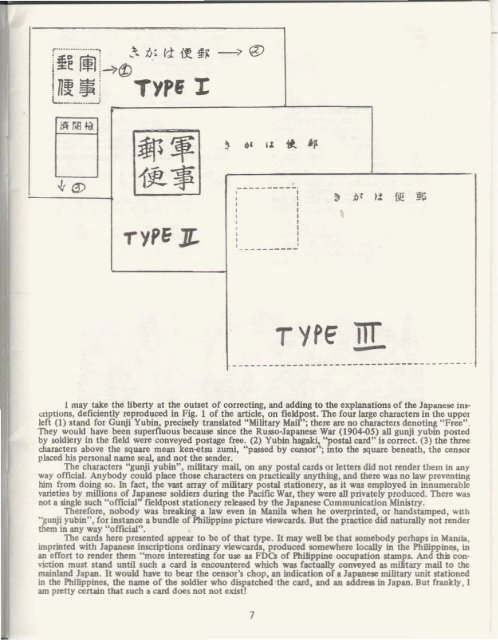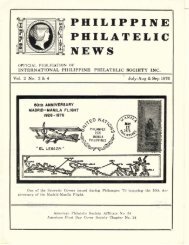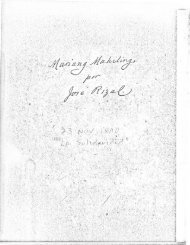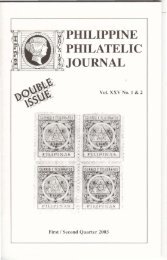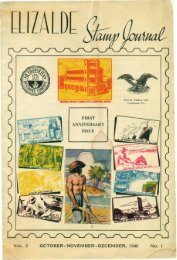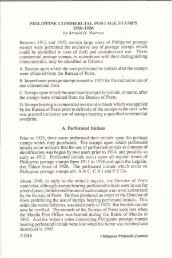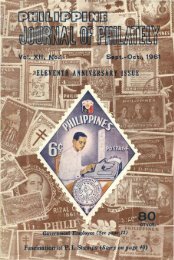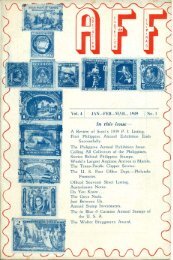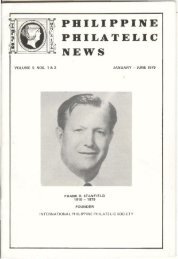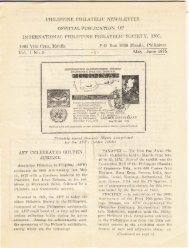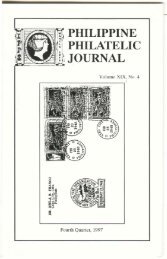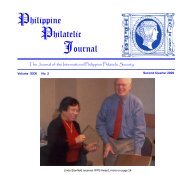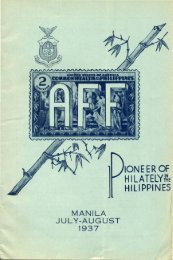April-December 1977, Vol. 3, No.s 2-4 - International Philippine ...
April-December 1977, Vol. 3, No.s 2-4 - International Philippine ...
April-December 1977, Vol. 3, No.s 2-4 - International Philippine ...
You also want an ePaper? Increase the reach of your titles
YUMPU automatically turns print PDFs into web optimized ePapers that Google loves.
·····;;········l ,\ fJ~ Ii ~ f~ -;> ~<br />
!i~ ~:_)®<br />
in! ~~<br />
L_._......._=<br />
U<br />
TYP'<br />
:r<br />
,<br />
.<br />
U<br />
~<br />
11!.~<br />
O' 11 il. j~<br />
{, S) ---------_.<br />
,<br />
I<br />
I<br />
,<br />
,<br />
-ryPE JL.<br />
I---------- !<br />
'"<br />
b' /J. @.! Jli<br />
-TIT<br />
TYP~<br />
----------------------------------------<br />
1 may take the liberty at the outset of correcting, and adding to the explanations of the Japanese inscoptions,<br />
deficiently reproduced in Fig. 1 of the article, on fieklf,0st. The four large characters in the upper<br />
left (1) stand for Gunji Yubin, precisely translated "Military Mail '; there are no characters denoting "Free".<br />
They would have been superfluous because since the Russo-Japanese War (l904..QS) all gunji yubin posted<br />
by soldiery in the field were conveyed postage free. (2) Yubin hagaki, "postal card" is conect. (3) the three<br />
characters above the square mean ken-etsu zumi, "passed by censor"; into the square beneath, the censor<br />
placed his personal name seal, and not the sender.<br />
The characters "gunji yubin", military mail, on any postal cards or letters did not render them in any<br />
way official. Anybody could place those characters on practically anything, and there was no law preventing<br />
him from doing so. In fact, the vast array of military postal stationery, as it was employed in innumerable<br />
varieties by millions of Japanese soldiers during the Pacific War, they were an privately produced. There was<br />
not a single such "official" fieldpost stationery released by the Japanese Communication Ministry.<br />
Therefore, nobody was breaking a law even in Manila when he ovetprinted, or handstamped, wah<br />
"gunji yubin", for instance a bundle of <strong>Philippine</strong> pictwe viewcards. But the practice did naturally not render<br />
them in any way "official".<br />
The cards here presented appear to be of that type. It may well be that somebody perhaps in Mamla.<br />
imprinted with Japanese inscriptions ordinary viewcards, produced somewhere locally in the <strong>Philippine</strong>s, in<br />
an effort to render them "more interesting for use fU FOes of <strong>Philippine</strong> occupation stamps. And this conviction<br />
must stand until such a card is encountered which was factually conveyed as military mail to the<br />
mainland Japan. It would have to bear the censor's chop, an indication of a Japanese military unit stationed<br />
in the <strong>Philippine</strong>s, the name of the soldier who dispatched the card, and an address in Japan. But frankly, I<br />
am pretty certain that such a card does not not exist!<br />
7


